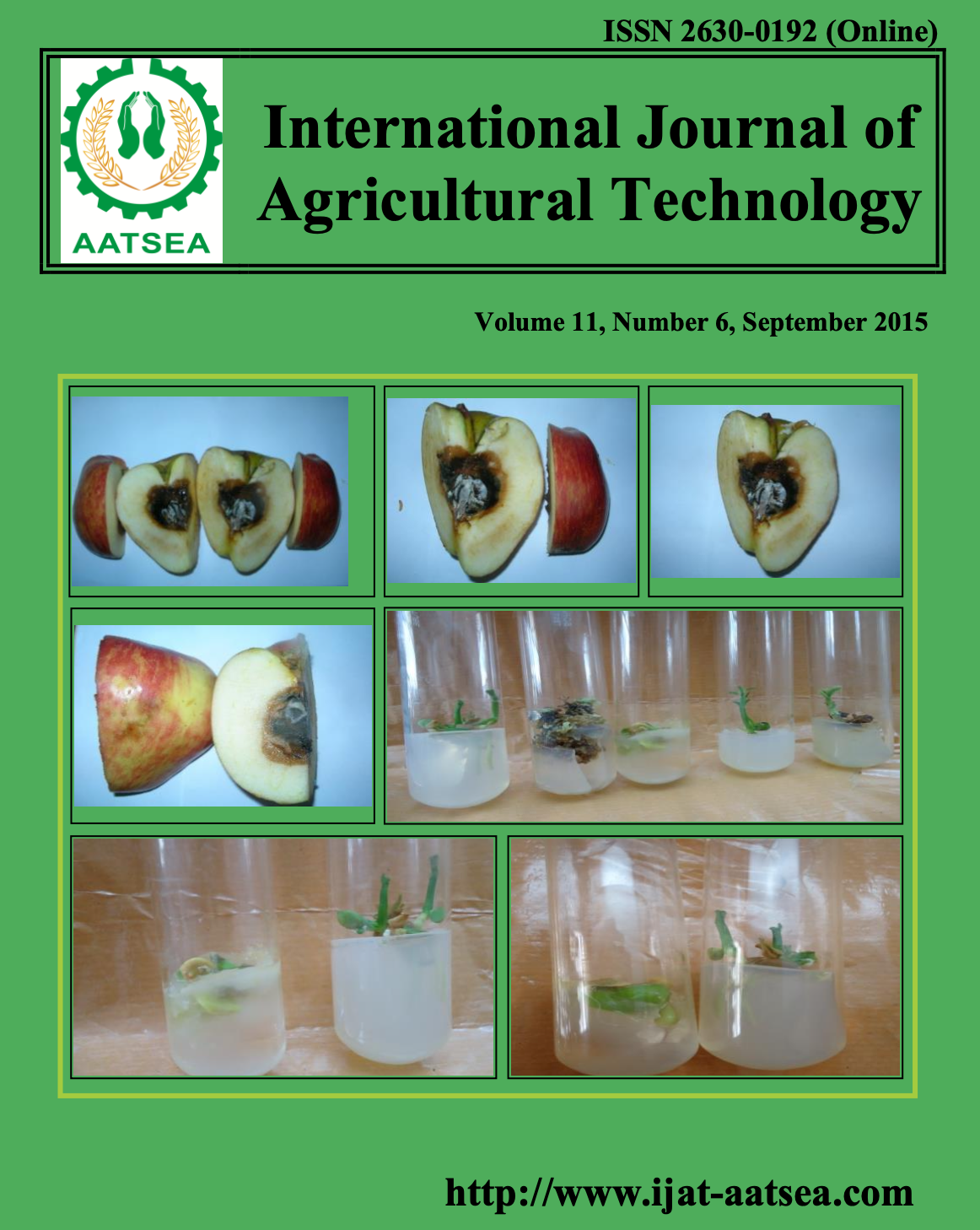Seed-borne fungi of some peanut varieties from Hadhramout and Abyan Governorates in Yemen
Main Article Content
Abstract
Article Details

This work is licensed under a Creative Commons Attribution-NonCommercial-NoDerivatives 4.0 International License.
References
Ameer, J., Begum, M., Venudevan, B. and Jayanthi, M. (2013). Storage fungi in groundnut and the associate seed quality deterioration-a review. Plant Pathology Journal 12:127-134.
Bhattacharya, K. and Raha, S. (2002). Deteriorative changes of maize, groundnut and soybean seeds by fungi storage. Mycopathologia 155:135-141.
Booth, C. (1971). The genus Fusarium. England: Commonwealth Agricultural Bureaux.
Chavan, A. M. and Kakde, R. B. (2008). Studies on abnormal oilseeds mycoflora from Marathwada region. Bionano Frontier 2:101-104.
Chavan, A. M. and Kakde, R. B. (2008). Studies on abnormal oilseeds mycoflora from Marathwada region. Bionano Frontier 2:101-104.
Chidambaram, P. S. and Mathur, S. B. (1975). Deterioration of grains by fungi. Annual Review of Phytopathology 3:69-89.
Council for Agricultural Science and Technology (CAST) (2003). Mycotoxins: Risks to plants, animals and human systems. Iowa U.S.A.: CAST. Ames.
Dawar, S. (1994). Studies on some seed-borne fungi associated with sunflower. (Doctor of Philosophy’s Thesis). University of Karachi, Pakistan.
Dawar, S. and Ghaffar, A. (1991). Detection of the seed borne mycoflora of sunflower. Pakistan Journal of Botany 23:173-178.
Ellis, M. B. (1971). Dematiaceous Hyphomycetes Commnwealth Mycological Institute. Kew, Surrey England: Commonwealth Mycological Institute.
Elwakil, M. A. and El-Metwally, M. A. (2001). Seed-borne fungi of peanut in Egypt; pathogenicity and transmission. Pakistan of Biological Science 4:63-68.
Food and Agricultural Organization (FAO, 2004). Production Year Book, United Nations Organization, various issues.
Genstat (1995). (CD-ROM). Lowes Agricultural Trust (Rothamsted Experimental Station).
Ibiam, O. F. A. and Egwu, B. N. (2011). Post-harvest seed- borne diseases associated with the seeds of three varieties of groundnuts, (Arachis hypogaea L.) Nwakara, Kaki and Campalla. Agriculture and Biology Journal of North America 2:598-602.
International Seed Testing Association (ISTA) (1993). International Rules for Seed testing, Seed Science and Technology, 21 Supplement Rules.
International Seed Testing Association (ISTA) (1996). International Rules for Seed testing. Seed Science and Technology 24:39-42.
Janardhan, A., Subramanyam, D., Praveen Kumar, A., Reddi Pradeep, M. and Narasimha, G. (2011). Aflatoxin impacts on germinating seeds. Annals of Biological Research 2:180-188.
Jehlan, I. M. (2013). Management of rot disease on peanut by organic amendments and antagonistics. (Doctor of Philosophy’s Thesis). University of Aden.
Khan, S. A. J., Khanzada, A. K., Sultana, N. and Aslam, M. (1988). Evaluation of seed health testing techniques for the assessment of seed borne mycoflora of rice. Pakistan Journal of Agricultural Research 9:502-505.
Malone, G. P. and Muskette, A. E. (1964). Seed borne fungi: Description of 77 fungal species. Proceedings of the International Seed Testing Association 29:180-183.
Manimurugan, C. (2003). Pathogen free seed production in black gram (Vigna mungo (L.) Hepper). (Master’s Thesis). TamilNadu Agricultural University.
Mathur , S. K., Mathur, S. B. and Neergaard (1975). Detection of ssed-borne fungi in sorghum and location of Fusarium moniliforme in seed. Seed Science and Technology 3:683- 690.
Mathur, S. B. and Jorgensen, J. (1992). Seed pathology. Proceeding of the Technical centre for Agricultural and Rural Cooperation (CTA) seminar held at Copenhagen, Denmark. pp. 41- 62.
Mathur, S. B. and Kongsdal, O. (2003). Common laboratory seed health testing method for detecting fungi. First edition, International Seed Testing Association. Switzerland: Bassersdorf. pp: 425.
Mukherjee, P. S., Nandi, S. K. and Nandi, B. (1992). Deteriorative change in Groundnut seeds in storage. Journal of Mycopathological Research 30:113-119.
Neergaard, P. and Saad, A. (1962). Seed health testing of rice: A contribution to development of laboratory routine testing methods. Indian Phypatopathology 15:85-111.
Oladipupo, O. A. (2011). Effect of seed-Borne fungi on percentage germination and health of Groundnut seedlings. (Master’s Thesis). College of Plant Science and Crop Production.
Patra, A. K., Tripathy, S. K. and Samui, R. C. (2000). Effect of drying and storage methods on seed quality of summer groundnut (Arachis hypogaea L.). Seed Research 28:32-35.
Pursglove, J. W. (1984). Tropical Crops Dicotyledons. New York: John Wiley.
Rasheed, S., Dawar, S. and Ghaffar, A. (2004). Location of fungi in groundnut seed. Pakistan Journal of Botany 36:663-668.
Rodricks, J. V. (1976). Mycotoxins and other fungal related food problems. Advances in Chemistry Series 149. Washington: American Chemicals Society.
Singh, B. and Singh, U. (1991). Peanut as a source of protein for human foods. Plant Food for Human Nutrition 41:165-177.
Naqvi, S. D. Y., Shiden, T., Merhawi, W. and Mehret, S. (2013). Identification of seed-borne fungi on farmer saved sorghum (Sorghum bicolor L.), Pearl millet (Pennisetum glaucum L.) and groundnut (Arachis hypogaea L.) seeds. Agricultural Science Research Journals 3:107-114.
Turner, P. C., Moore, S. E., Hall, A. J., Prentice, A. M. and Wild, C. P. (2003). Modification of immune function through exposure to dietary aflatoxin in Gambian children. Environmental Health Perspectives 111:217-220.
Umechuruba, C. I. (1986). Longevity and Pathogenicity of fungi isolated from groundnut (Arachis hypogaea L) seed lots from Nigeria stored at 5 °C. Ebonyi State. Nigeria: Department of Applied Biology, Ebonyi State University Abakaliki
Wikipedia, the free encyclopedia (2012). List of fungi on Groundnut.


